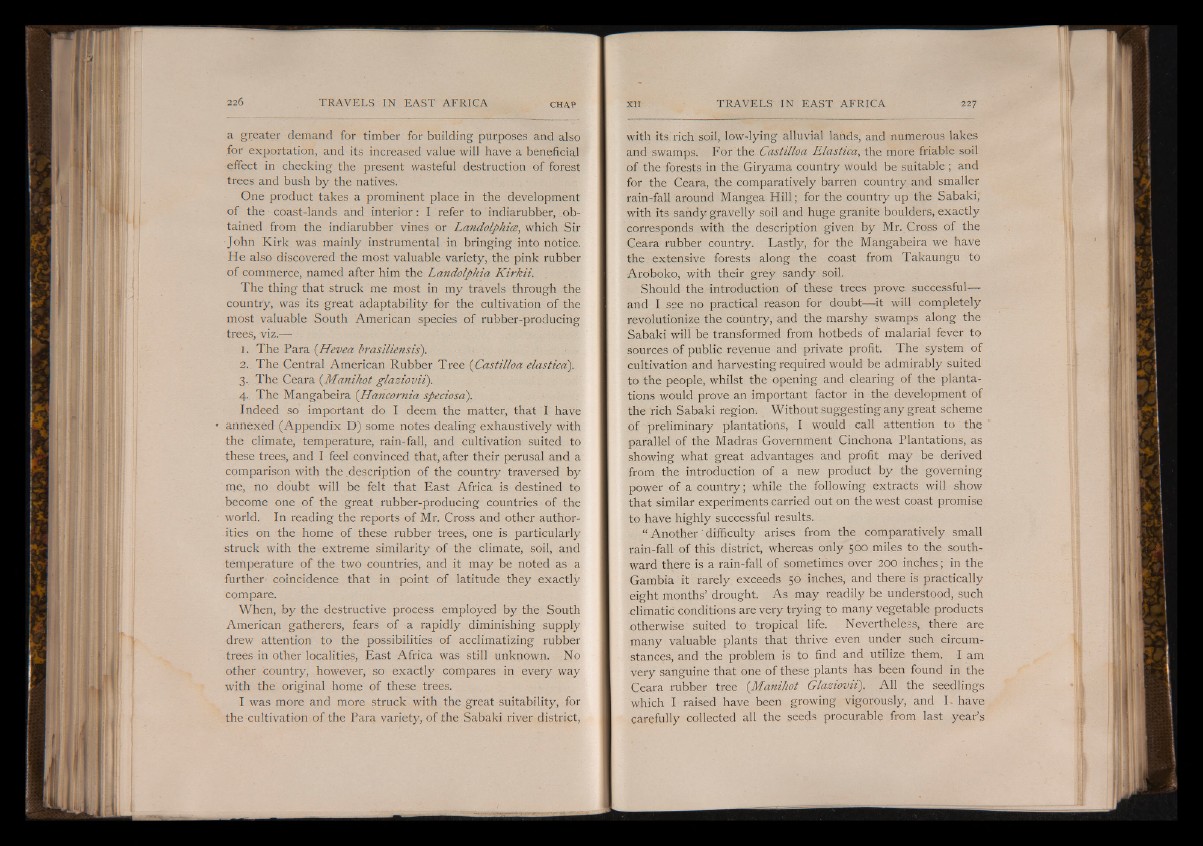
a greater demand for timber for building purposes and also
for exportation, and its increased value will have a beneficial
effect in checking the present wasteful destruction of forest
trees and bush by the natives.
One product takes a prominent place in the development
of the coast-lands and interior: I refer to indiarubber, obtained
from the indiarubber vines or Landolphia, which Sir
John Kirk was mainly instrumental in bringing into notice.
He also discovered the most valuable variety, the pink rubber
of commerce, named after him the Landolphia Kirkii.
The thing that struck me most in my travels through the
country, was its great adaptability for the cultivation of the
most valuable South American species of rubber-producing
trees, viz.—- :
1. The Para (Hevea brasiliensis).
2. The Central American Rubber Tree (Castilloa elastica).
3. The Ceara (Manihot glasiovii).
4. The Mangabeira (Hancomia speciosd).
Indeed so important do I deem the matter, that I have
• annexed (Appendix D) some notes dealing exhaustively with
the climate, temperature, rain-fall, and cultivation suited to
these trees, and I feel convinced that, after their perusal and a
comparison with the description of the country traversed by
me, no doubt will be felt that East Africa is destined to
become one of the great rubber-producing countries of the
■ world. In reading the reports of Mr. Cross and other authorities
on the home of these rubber trees, one is particularly
struck with the extreme similarity of the climate, soil, and
temperature of the two countries, and it may be noted as a
further coincidence that in point of latitude they exactly
compare.
When, by the destructive process employed by the South
American gatherers, fears of a rapidly diminishing supply
drew attention to the possibilities of acclimatizing rubber
trees in other localities, East Africa was still unknown. No
other country, however, so exactly compares in every way
with the original home of these trees.
I was more and more struck with the great suitability, for
the cultivation of the Para variety, of the Sabaki river district,
with its: rich soil, low-lying alluvial lands, and numerous lakes
and swamps. For the Castilloa Elastica, the more friable soil
of the forests in the Giryama country would be suitable ; and
for the Ceara, the comparatively barren country and smaller
rain-fall around Mangea Hill; for the country up the Sabaki;
with its sandy gravelly soil and huge granite boulders, exactly
corresponds with the description given by Mr. Cross of the
Ceara rubber country. Lastly, for the Mangabeira we have
the extensive forests along the coast from Takaungu to
Aroboko, with their grey sandy soil.
Should the. introduction of these trees prove successful—
and I see no practical reason for doubt-||it will completely
revolutionize the country, and the marshy swamps along the
Sabaki will be transformed from hotbeds of malarial fever to
Sources of public revenue and private profit. The system of
cultivation and harvesting required would be admirably suited
to the people, whilst the opening and clearing of the plantations
would prove an important factor in the development of
the rich Sabaki region. Without suggesting any great scheme
of preliminary plantations, I would call attention to the
parallel of the Madras Government Cinchona Plantations, as
showing what great advantages and profit may be derived
from the introduction of a new product by the governing
power of a country ; while the following extracts will show
that similar experiments carried out on the west coast promise
to have highly successful results.
“ Another difficulty arises from the comparatively small
rain-fall of this district, whereas only 500 miles to the southward
there is a rain-fall of sometimes over 200 inches ; in the
Gambia it rarely exceeds 50 inches, and there is practically
eight months’ drought. As may readily be understood, such
climatic conditions are very trying to many vegetable products
otherwise suited to tropical life. Nevertheless, there are
many valuable plants that thrive even under such circumstances,
and the problem is to find and utilize them. I am
very sanguine that one of these plants has been found in the
Ceara rubber tree (Manihot Glaziovii). All the seedlings
which I raised have been growing vigorously, and I. have
carefully collected all the seeds procurable from last year’s